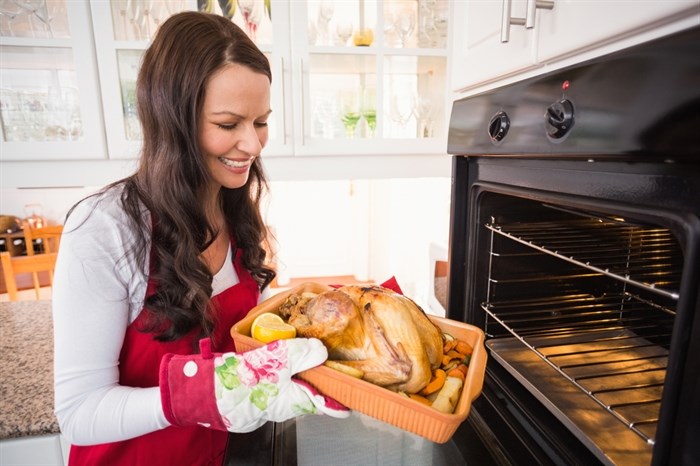
Image Credit: Shutterstock
October 10, 2015 - 9:30 AM
THOMPSON-OKANAGAN - It's that time of year when families gather to share a turkey feast so here's some tips to make sure festivities remain salmonella-free.
To avoid symptoms of food poisoning such as stomach cramps, nausea, vomiting, diarrhea and fever there are four basic steps to follow.
1. When preparing any food, wash your hands and wash surfaces with warm soapy water, before and after food have been in contact. Take the time to do a proper job. Wet hands, use soap and rub together for at least 20 second before rinsing.
2. Separate raw foods such as meat and eggs from cooked foods and ready-to-eat foods.
3. Cook foods to a safe internal temperature. A simple, inexpensive digital thermometer designed for meat will do the trick. They can be purchased at department stores and some larger grocery store chains.
4. When the feast is over, get those good leftovers into the fridge before retiring to the sofa to nap it off. The fridge needs to be set at 4 Celcius (40 F) or below.
There are a few other things the government wants you to know about food safety.
Thawing a frozen bird
The safest way to get this job done is in the refridgerator. Place the bird breast side up in a clean container or on a platter to catch leaking, raw juices. o thaw poultry, place it breast side up in a clean container or platter that will hold any raw juices that may leak out. Place this container or platter on the bottom shelf of the refrigerator to prevent contaminating other foods in the refrigerator. You should defrost poultry 24 hours for each 2.5 kg (5 pounds) of bird. Cook poultry immediately after it has thawed. You can safely re-freeze defrosted poultry if the meat is still cold and ice crystals are still present.
If you choose to thaw your poultry in water it can be done in two ways:
Under cold running drinking water: Thoroughly clean and sanitize the sink before thawing the poultry. It should be wrapped in leak-proof plastic or its original wrapping to prevent cross-contamination. Run cold water on the poultry until it has thawed.
Soak the poultry in cold drinking water: Use a clean container to hold the poultry. Wrap it in leak-proof plastic to prevent cross-contamination. Place the poultry breast side down and cover with cold water. Change the water every 30 minutes to keep the surface cold. Keep doing this until the poultry is thawed.
If you thaw by microwave, cook the poultry immediately once it has thawed. Remember, to avoid cross-contamination, thoroughly wash your hands, and clean and sanitize the sink and all other utensils, dishes, and surfaces that come into contact with raw poultry and its juices.
Turkey and stuffing
If you are cooking a turkey this holiday season, make sure it is cooked properly by checking the internal temperature with a digital food thermometer. The thermometer should be inserted into the thickest part of the breast or thigh. Cook turkey to a minimum internal temperature of 85°C (185°F).
To avoid cross-contamination, cook stuffing separately—either in its own oven dish or on the stove top. If you do stuff your turkey, stuff it loosely just before roasting and remove all stuffing immediately after cooking. Cook stuffing to a minimum internal temperature of 74°C (165°F) and refrigerate within two hours of cooking.
Baking
Kids love to lick the spoon or beaters clean, but they are the ones most likely to get sick from doing it. Dough, batter or frosting that contains raw egg may also contain bacteria such as Salmonella, which can cause severe food poisoning.
Eggnog
Eggnog is a holiday favourite. Store-bought eggnog is pasteurized and does not require heating to kill harmful bacteria. If you decide to make eggnog at home, heat the egg-milk mixture to at least 71°C (160°F) and then refrigerate in small amounts using shallow containers so it cools quickly.
Holiday buffets
The most important food safety tip to consider when preparing a buffet meal is to keep hot foods hot and cold foods cold. To keep food hot, use warming trays, chafing dishes or crock pots. To keep food cold, put serving trays on crushed ice.
Refrigerate leftovers as soon as possible, no more than two hours from the time the food was cooked. If perishable foods have been sitting out at room temperature for more than two hours, throw them out.
LINKS:
Holiday food safety
Food safety tips for leftovers
Poultry facts
Be food safe - Canadian Partnership for Consumer Food Safety Education
Food safety - Public Health Agency of Canada
Food safety - Canadian Food Inspection Agency
To contact the editor, email mjones@infonews.ca or call 250-718-2724.
News from © iNFOnews, 2015